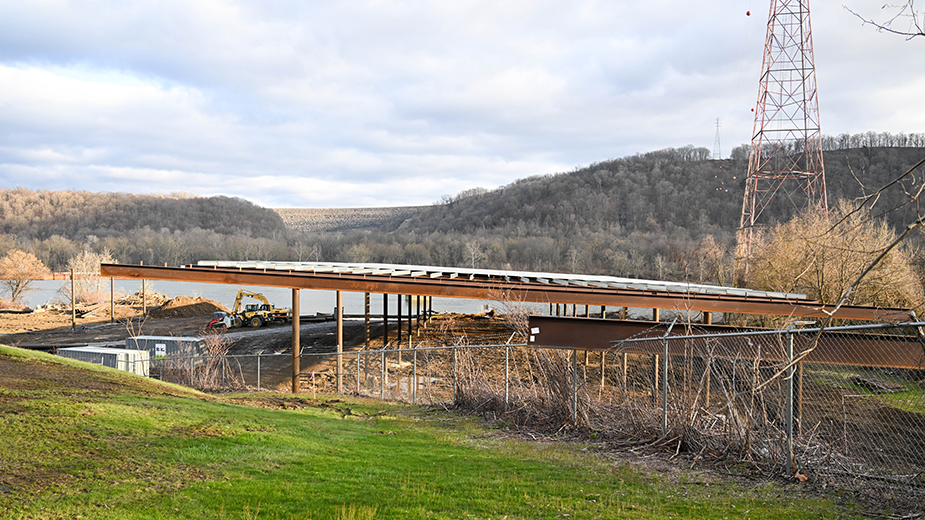YOUNGSTOWN, Ohio – Two Columbiana County municipalities have launched solar power projects that will lower their energy costs.
In East Liverpool, Scout Solar is installing solar panels along the Ohio River – in some cases 30-feet in the air because of the risk of submersion on the floodplain. And in Wellsville, new parking canopies soon will be constructed with solar panels on top.
Over the 25-year agreement between Arizona-based Scout Solar and the two communities, East Liverpool is slated to save more than $2.6 million and Wellsville will save over $700,000, according to Matt Brophey, project executive with the company.
Under the agreement, the communities allow Scout Solar to construct the panels on public land and then benefit from having an electricity source without transmission and distribution expenses.
Wellsville will have meters at four locations: village hall, the water treatment plant and two sewage booster stations.
Village Mayor Bob Boley says he additionally would like to see solar power as a backup plan for the floodwall pumps, which keep the Ohio River away from town during periods of sharp rise in water level. Boley notes the Army Corps of Engineers has urged Wellsville to find a backup solution.
At this point though, Ohio regulations are creating roadblocks because there is not enough property to install the needed solar panels near the electricity meter for the village’s pumps.
Still, Brophey is hopeful Ohio House Bill 197 will change that.
In West Virginia and Pennsylvania, a homeowner or business owner can place the solar array anywhere within a two-mile radius of the meter to power the facility through that meter. But in Ohio it must be on that parcel or an adjacent parcel that is owned or leased by the entity paying through the meter, which limits the ability for some to switch to solar.
In East Liverpool, for instance, Brophey says there are some pump stations located inside 10-foot by 10-foot buildings, which are on small parcels just a bit larger than the building. That is not enough space to install the number of solar panels needed to generate offsetting electricity.
The House bill would change that in Ohio, where 0.2% of energy is solar generated, according to Brophey.
“What’s more exciting is the intent of the bill that would make it so municipalities such as East Liverpool, Wellsville, anyone in the state can get together and form their own aggregation, putting up solar arrays on city property. Then they could sign the public up for power purchase agreements and they would effectively become the electric provider for their city,” Brophey says, adding that could become a revenue source for the municipality.
Rick Stockburger, president and CEO of Brite Energy Innovators in Warren, believes the economics of solar power will drive it forward.
“If you can put solar on your property and get consistency in your energy costs, you can create all your own fuel and for the next 30 years be paying the exact same price,” Stockburger says. “How great is that for farming?”
Erin Quinlan, co-owner of Canopy Solar of Salem, agrees.
“The sun’s not going away anytime soon and we see a lot of farms and businesses trying to control costs,” Quinlan says. “We see farms basically wanting to set up the next generation of farming with low operating costs. If they can reduce costs, then it just makes the farm that much more profitable.”
Canopy Solar, which recently rebranded from Valley Energy Solar, is helping those with homes, farms and commercial properties in northeastern Ohio and western Pennsylvania achieve consistency of energy cost.
The company owned by Erin Quinlan and her husband, Dan, installs solar panels on rooftops and the ground and then handles the connection into the electrical system for the home or business. At that point, the sun can provide the needed power for the homeowner or company, either enough to totally offset the energy costs by providing them with credits or at least reducing their energy bills.
The technology continues to improve and evolve, and Quinlan says battery storage for a backup generator is becoming very popular.
The larger challenge can be obtaining permits. Quinlan believes the process will become easier with education about the financial and environmental benefits – as well as the safety – of solar.
Yet there are efforts in the local area to regulate the installation of solar panels.
Mahoning County commissioners recently banned large solar and wind farms in unincorporated areas in the townships of Austintown, Beaver, Berlin, Canfield, Coitsville, Goshen, Jackson, Milton, Poland and Springfield.
Their decision came after Columbiana County commissioners also banned large-scale wind and solar farms in the unincorporated areas of all 18 townships in that county.
“I really think it’s important that everybody does a little bit of research before we are putting in policies that could affect a resident’s freedom on how they want to power their home and how they want to save money,” says Quinlan, who offers to speak to any group interested in learning about solar.
Tony Frisone, co-founder and CEO of CZAR-Power, says areas that do not embrace new energy technologies run the risk of being left behind.
“I can tell you as somebody who is working in this industry, we’ll go where we are celebrated, not where we are tolerated,” Frisone says. “Innovators will go to the places where they’re not having to deal with people treating them with open hostility and grow their businesses there.”
Pictured at top: Scout Solar is installing panels on the banks of the Ohio River in East Liverpool.
